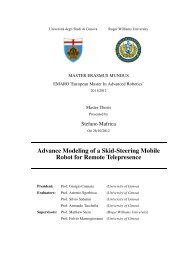William M. Acker, Jr. Northern District of Alabama - Roger Williams ...
William M. Acker, Jr. Northern District of Alabama - Roger Williams ...
William M. Acker, Jr. Northern District of Alabama - Roger Williams ...
- No tags were found...
You also want an ePaper? Increase the reach of your titles
YUMPU automatically turns print PDFs into web optimized ePapers that Google loves.
On December 15, 1995, a second sentencing hearing was held. Throughout the proceeding,Judge <strong>Acker</strong> expressed his frustration with the Eleventh Circuit’s double jeopardy analysis,the 924(c) statute, and the remand order. With regard to the double jeopardy issue, the judgewas surprised that his analysis had been rejected, stating that “[The 924(c) <strong>of</strong>fense] hasexactly the same elements, essential elements. . . . [I]t never occurred to me that Congresscould intend its way around the Fifth Amendment, but apparently it can.”8As a result <strong>of</strong> the remand, Rodney faced consecutive sentences for using a firearm during acrime <strong>of</strong> violence. Under 924(c), a first <strong>of</strong>fense carries a five year sentence which ismandatory and consecutive to any other sentence. At the time, a second conviction under thisstatute carried a twenty year sentence, with the same mandatory and consecutive requirement.Moreover, the Supreme Court had held that the twenty year sentence for a second 924(c)<strong>of</strong>fense applies even to multiple 924(c) counts in the same indictment. The only requirementfor “stacking” 924(c) counts and penalties is that the second <strong>of</strong>fense occurred on a subsequentdate. Nor does it matter whether multiple 924(c) counts rely on the use <strong>of</strong> the same gun or ifthe underlying <strong>of</strong>fenses are part <strong>of</strong> the same conspiracy.9At the second sentencing hearing, Judge <strong>Acker</strong> was clearly frustrated by the mandatorynature <strong>of</strong> the 924(c) penalties and that this statute essentially added a completely independentsentencing regime on top <strong>of</strong> and in addition to the Guidelines sentence for Rodney’s crime.He said that for the gun counts, “. . . the Guidelines don’t have anything to do with it. Thereis no point in my sitting here talking about the Guidelines. . . . Forget Guidelines. Guidelinesjust don’t apply. It doesn’t make any difference whether these two defendants, either one <strong>of</strong>them, has 20 murder convictions in their past or none.”10The remand from the appellate court created an additional problem for Judge <strong>Acker</strong>. Hemade clear that he wanted the total sentence to reflect his assessment <strong>of</strong> the case, but theremand from the Court <strong>of</strong> Appeals appeared to direct him only to sentence on the gun counts.He began the hearing by asking the attorneys whether the Eleventh Circuit opinion permittedhim to revisit his sentencing decisions on the other counts. He told them that he felt it was. . . inherently unfair to send the case back to me for sentencing under only one count,the gun count, the enhanced count, without also giving me the opportunity toresentence under the others, because at the time I sentenced, I was sentencing in thebelief that I could not sentence under the gun count.”11After going round this issue several times with the parties, Judge <strong>Acker</strong> ultimately concludedthat the panel’s opinion did not allow him any choice and that all he could do was sentenceSee United States v. Moore, 43 F.3d 568 (11 th Cir. 1995) (holding that Blockburger is a test <strong>of</strong>statutory construction, and therefore when as here, there is a clear intent for cumulative punishment,that test is not controlling.).8Sent. Tr. at 4.9Deal v. United States, 508 U.S. 129 (1993).10Sent. Tr. at 8-9.11Sent. Tr. at 3.
















